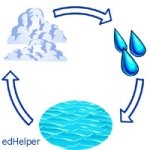
Worksheets and No Prep Teaching Resources
Reading Comprehension Worksheets
Water

Water
 Worksheets and No Prep Teaching Resources Reading Comprehension Worksheets Water |
 Water |
| edHelper's suggested reading level: | grades 3 to 4 | |
| Flesch-Kincaid grade level: | 7.45 |
|
Where Has Our Water Gone?
By Trista L. Pollard |

|
 1 "Where, oh where has our water gone?" Hopefully, we will never have to answer that question here on earth. It is easy to think that we have an unlimited supply of water. Every time we turn on our water faucets, we are rewarded with a steady flow of water. However, as the earth's population increases, our water use increases. New York City alone consumes about 1.8 million gallons (7 billion liters) of water every day! So where is most of our drinkable (fresh water) located?
1 "Where, oh where has our water gone?" Hopefully, we will never have to answer that question here on earth. It is easy to think that we have an unlimited supply of water. Every time we turn on our water faucets, we are rewarded with a steady flow of water. However, as the earth's population increases, our water use increases. New York City alone consumes about 1.8 million gallons (7 billion liters) of water every day! So where is most of our drinkable (fresh water) located? |
Create Weekly Reading Books
Prepare for an entire week at once! |
| Leave your feedback on Where Has Our Water Gone? (use this link if you found an error in the story) |
 |
Water
|
 |
Science
|